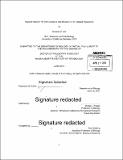| dc.contributor.advisor | Hidde L. Ploegh. | en_US |
| dc.contributor.author | Lee, Clarissa Ci | en_US |
| dc.contributor.other | Massachusetts Institute of Technology. Department of Biology. | en_US |
| dc.date.accessioned | 2014-09-19T21:30:09Z | |
| dc.date.available | 2014-09-19T21:30:09Z | |
| dc.date.copyright | 2014 | en_US |
| dc.date.issued | 2014 | en_US |
| dc.identifier.uri | http://hdl.handle.net/1721.1/89943 | |
| dc.description | Thesis: Ph. D., Massachusetts Institute of Technology, Department of Biology, 2014. | en_US |
| dc.description | Cataloged from PDF version of thesis. | en_US |
| dc.description | Includes bibliographical references. | en_US |
| dc.description.abstract | Nuclear factor-kappaB (NF-KB) is a family of transcription factors that are essential for execution of both the innate and the adaptive immune response. NF-KB regulates hundreds of genes involved in critical processes such as cell survival, differentiation, proliferation, and inflammation. Consequently, NF-KB activity must be tightly regulated and a failure to do so causes diseases such as inflammatory disorders and cancer. The identification of novel NF-KB regulators can increase our understanding of the elaborate regulatory networks that control the NF-kB response and influence the design of therapeutic interventions directed at NF-kB. A classical approach for identifying new members in a pathway is the forward genetic screen. Human haploid genetic screens represent a recent advance in this approach. I have attempted to expand the utility of human haploid genetic screens through the use of transcriptional reporters and developed human haploid reporter screens for the specific purpose of identifying regulators of NF-kB. To identify constitutive inhibitors of NF-kB, I utilized a NF-KBblasticidin S resistance gene (BSR) reporter and identified CYLD, a known negative regulator of NF-KB, demonstrating that in principle this approach works. In the same screen, two members of the poorly characterized leucine-rich repeat-containing 8 (LRRC8) family of proteins appeared as significant hits. I determined that LRRC8D is not required for NF-KB regulation, but rather for import of blasticidin, the selecting agent used in the screen. Thus, quite serendipitously, I identified the first mammalian protein that mediates import of the antibiotic blasticidin. My further characterization of LRRC8D provides new insight into the function of LRRC8 proteins. I developed a second screen, using a NF-KB-GFP reporter, to identify genes required to activate NF-KB in response to the TLR2/6 ligand, FSL-1. This screen successfully identified known components of the TLR2/6 pathway and identified many other candidate genes for further study. | en_US |
| dc.description.statementofresponsibility | by Clarissa Ci Lee. | en_US |
| dc.format.extent | 126 pages | en_US |
| dc.language.iso | eng | en_US |
| dc.publisher | Massachusetts Institute of Technology | en_US |
| dc.rights | M.I.T. theses are protected by copyright. They may be viewed from this source for any purpose, but reproduction or distribution in any format is prohibited without written permission. See provided URL for inquiries about permission. | en_US |
| dc.rights.uri | http://dspace.mit.edu/handle/1721.1/7582 | en_US |
| dc.subject | Biology. | en_US |
| dc.title | Haploid reporter screens aimed at identification of NF-kappaB regulators | en_US |
| dc.type | Thesis | en_US |
| dc.description.degree | Ph. D. | en_US |
| dc.contributor.department | Massachusetts Institute of Technology. Department of Biology | |
| dc.identifier.oclc | 890124198 | en_US |
